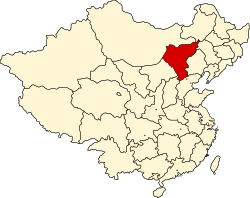Chahar Province
Chahar (
| province of the Republic of China 察哈爾省 Chahar Province (1928–1948) | |
 | |
| Capital | Changyuan[a] |
| Total Area | 278 957 km²
(107 706 sq mi) |
| Population | 2 150 054 |
| former province of the People's Republic of China 察哈尔省 Qahar Province (1948-1952) | |
 | |
| Capital | Zhangjiakou |
Administration and history
Chahar Province is named after the
Republic of China era
In 1913, the second year of the
|
|
|
In 1928, it became a province. The last five counties on the above list (starting from Xinghe) were partitioned to
|
|
|
All banners belong to the Shilingol League (ᠰᠢᠯᠢ ᠶᠢᠨᠭᠣᠤᠯ, 锡林郭勒盟).
From 1937 to 1945, it was occupied by Japan and made a part of Mengjiang, a Japanese-controlled region led by Mongol Prince Demchugdongrub of the Shilingol Alliance. The Chahar People's Anti-Japanese Army Alliance (察哈爾民眾抗日同盟軍) was established in Kalgan on May 26, 1933 by Feng Yuxiang (馮玉祥) and Ji Hongchang (吉鴻昌).
1948–1952
In 1952, six years after becoming communist, the province was abolished and divided into parts of
| Name | Administrative Seat | Simplified Chinese | Hanyu Pinyin | Subdivisions |
|---|---|---|---|---|
| Zhangjiakou | Zhangjiakou | 张家口市 | Zhāngjiākǒu Shì | none |
| Datong | Datong | 大同市 | Dàtóng Shì | none |
| Yanbei Division | Datong County | 雁北专区 | Yànběi Zhuānqū | 13 counties |
| Qanan Division | Xuanhua County | 察南专区 | Chánán Zhuānqū | 11 counties |
| Qabei Division | Zhangbei County | 察北专区 | Cháběi Zhuānqū | 9 counties |
Geography
Chahar Province was divided north-south by the Great Wall, with North Chahar being the larger in area and South Chahar, with the capital, Zhangjiakou, being far larger in population. It had an area of 278.957 km2 (107.706 sq mi). In North Chahar most of the land was part of the northeastern extension of the Gobi Desert.
Bordered
- North: Xing'an
- North and West: Mongolia
- West and South : Suiyuan
- South: Shanxi and Hebei
- East: Rehe and Liaobei
See also
Notes
References
- OCLC 32634034
- OCLC 24615818
- ^ a b Aberle, David Friend; Vreeland, Herbert Harold (1957). Chahar and Dagor Mongol Bureaucratic Administration: 1912–1945 (2nd ed.). New Haven, Connecticut: HRAF Press. OCLC 7421313
